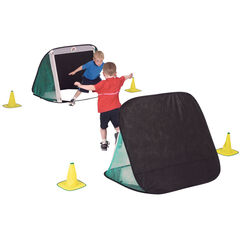
Tailor school football activities to different age groups
Early Years Football (Ages 3-5)
At this stage, the focus should be on fun, movement and basic football skills rather than competitive play.
Key Adaptations:
- Use soft, lightweight balls that are easier for small hands to grip and control.
- Focus on simple activities like dribbling around cones or kicking the ball into a large target.
- Avoid formal matches; instead, encourage free play and exploration with the ball.
- Keep sessions short (20-30 minutes) to match young children’s attention spans.
- Use colourful equipment to make activities more engaging and visually stimulating.
Coaching Tips:
- Use imaginative games that incorporate football skills, such as ‘sharks and minnows’ with the ball.
- Praise effort and participation rather than skill level or scoring goals.
- Encourage parents to join in when possible, making it a fun family activity.
Key Stage 1 Football (Ages 5-7)
As children develop better coordination and understanding, you can introduce more structured activities while maintaining a playful approach.
Key Adaptations:
- Use size 3 footballs, which are lighter and easier to control.
- Play small-sided games (3v3 or 4v4) without goalkeepers to encourage more touches on the ball.
- Use smaller pitches (approximately 20×15 metres) to suit children’s physical capabilities.
- Introduce basic rules gradually, focusing on fair play and respect for others.
Coaching Tips:
- Incorporate plenty of ball time for each child; avoid activities with long queues.
- Use simple, clear instructions and demonstrate skills visually.
- Rotate positions frequently to give children experience in different roles.

Make adaptations include ball size and pitch length depending on age
Key Stage 2 Football (Ages 7-11)
At this stage, children are ready for more structured play and can begin to understand tactical concepts.
Key Adaptations:
- Progress to 5v5 or 7v7 games on larger pitches (approximately 40×30 metres for 7v7).
- Introduce goalkeepers and basic positional play.
- Use size 4 footballs, which offer a good balance between control and distance.
- Implement simplified offside rules to prepare children for full-sized games.
Coaching Tips:
- Begin to introduce basic tactical concepts like spacing and teamwork.
- Encourage problem-solving by asking questions rather than always providing solutions.
- Implement fun skill challenges to motivate individual improvement.
Key Stage 3 Football (Ages 11-14)
As children enter secondary school, they’re ready for more complex aspects of the game.
Key Adaptations:
- Move towards 9v9 or 11v11 games on larger pitches.
- Introduce full offside rules and other more advanced regulations.
- Use size 5 footballs (standard adult size) to prepare for full-sized games.
- Implement longer playing times, typically two 30-minute halves.
Coaching Tips:
- Focus on developing individual skills within team play.
- Introduce more advanced tactical concepts like formations and set-pieces.
- Encourage players to analyse their own performance and set personal goals.

Focus on developing individual skills within team play.
Key Stage 4 Football and Beyond (Ages 14+)
At this stage, players are transitioning to adult football, but it’s important to remember that they’re still developing physically and mentally.
Key Adaptations:
- Play full 11v11 matches on standard-sized pitches.
- Implement all official rules, but ensure they’re applied with an understanding of the players’ age and experience.
- Consider players’ physical development when planning training sessions and match play.
Coaching Tips:
- Focus on refining technical skills and developing tactical understanding.
- Encourage leadership and decision-making on the pitch.
- Provide opportunities for players to specialise in preferred positions while maintaining overall versatility.

Encourage other life skills like leadership and cooperation
Inclusive Adaptations for All Ages
When adapting football for different age groups, it’s crucial to consider inclusivity to ensure all children can participate, regardless of their abilities.
General Inclusive Adaptations:
- Use brightly coloured equipment for visually impaired players.
- Implement ‘silent football’ sessions where players use hand signals to communicate, benefiting hearing-impaired players and developing non-verbal communication skills for all.
- Allow ‘roll-ins’ instead of throw-ins for players with limited upper body mobility.
- Use flat, smooth surfaces for wheelchair users or those with mobility aids.
The Importance of Gradual Progression
As you adapt football for different age groups, remember that progression should be gradual. Children develop at different rates, so flexibility is key. Some may be ready for more advanced concepts earlier, while others may need more time with the basics.
Tips for Smooth Progression:
- Regularly assess players’ skills and understanding to ensure they’re in the appropriate group.
- Provide opportunities for more advanced players to mentor younger ones, fostering leadership skills.
- Maintain open communication with parents about their child’s development and the rationale behind age-group adaptations.
Adaptation, Flexibility and Fun!
Adapting football for different age groups is essential for ensuring that all children can enjoy the sport, develop their skills, and stay safe. By tailoring the game to suit each age range, we can create a positive football experience that encourages lifelong participation and love for the beautiful game. Remember, the key to successful adaptation is flexibility, creativity, and a focus on fun. By keeping these principles in mind, you can create engaging football sessions that cater to the needs and abilities of all age groups, fostering a new generation of football enthusiasts.

Whether you’re coaching toddlers taking their first kicks or teenagers honing their skills, adapting the game appropriately will help every player reach their full potential and, most importantly, enjoy the journey along the way.
Shop the full range of TTS footballs here.
Author: Rachael Sutcliffe
Rachael is a marketing manager, copywriter and mum of two with almost 20 years of experience in the education industry, working for leading educational resource suppliers and toy manufacturers.







